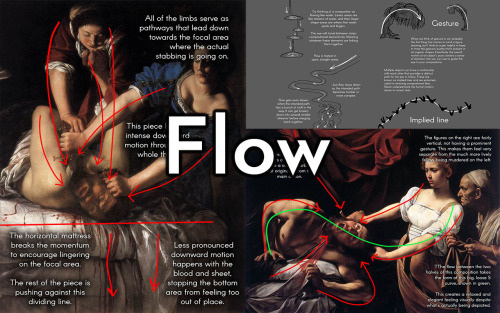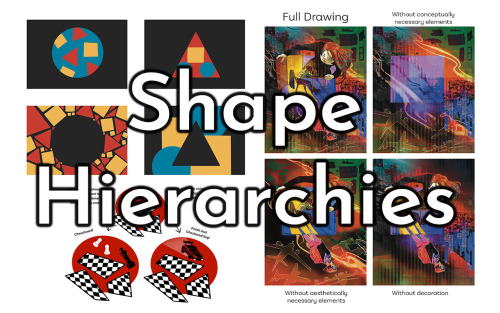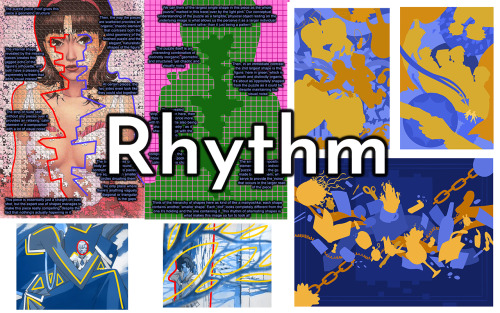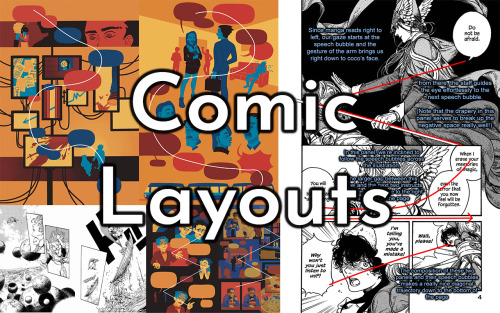How To Improve Drawing Kinda Fast:
how to improve drawing kinda fast:
ditch lineart for a bit (this way its easier to part with things that aren’t working)
use a REALLY thin brush
copy, copy, copy art you think is ✨art goals✨
don’t post that stuff tho :O
if you need to trace at first, thats fine lol but break away from that eventually!! you gotta train your eyes to draw what you see, spatial awareness is very important
copy hands, poses, expressions, anything you wanna get better at
don’t copy from refs that are way too simple to be used as a “master study”, like from the calarts shows etc.
copy from stuff thats kinda complex bc if you learn how to draw it in that complex way, you can always simplify it if you want ^^
im pretty sure this is how many of us have become obsessed with hip dips details LOL
if something looks off, flip ur canvas, mess with ur sketch, or even delete (or hide) parts of the sketch and try again. if you drew it once, u can draw it again. (erase or hold up the page to the light backwards if drawing on paper)
being cool with parting with your sketch if its not working will make you a better artist
youre allowed to frankenstein refs together lol (a hand from here, a mouth from there…)
if youre having trouble making your sketches look like theres actual shapes, try shading :D
literally the only reason i shade now is to show the shapes of objects in more of a painterly way (its not just for paintings btw, its just easier to describe it that way)
try new things that youre excited about like perspective, anatomy, blah blah
copy!!!! while youre copying it’s gonna be cool to see how much you remember when you try it on your own
scribble a doodle as often as you can, not like urgently, but like as something to look forward to (like how lots of ppl look forward to wordle everyday lol)
this list can apply to anyone but its fine if you wanna take some advice and leave some if it doesn’t work out. this list is mostly just to get you comfortable with sketching and learning, not performing.
I mention that “not performing” thing bc its easy to want to please social media platforms because that attention and validation can feel amazing!
but its also addicting because many of us crave being in a community and talking to ppl who like the same things we do
there are many communities out there from artist youtubers, artist streamers, etc. and many of them have discords and stuff and it might be fun to join! and/or join fandom ones if u want ^^
that way you have something thats not bound by if ig decides to not show your post to your followers or something
there’s also lots of other platforms that aren’t social media based specifically for artist communities too!
with this said, please be safe! never give out private info and you’re always free to block/report ppl who make u uncomfortable or ask weird things.
on the topic of being in communities… reblog art you like! comment the nice things youre thinking in the tags or in an actual comment! share art you like on your ig story!
firstly, this is great for making friends
secondly, the artist cant read ur mind so they don’t hear anything nice youre saying :(
comments can be so motivating!! hearing nice things from my mutuals about my art feels great bc of that authentic human connection we’ve all been missing for like 2 years now
if i see a mutual drawing something and i think “omg they did amazing with the expression!” i write it (ive also been told i leave comments as if im talking and its kinda funny to read sometimes xD)
its channeling “girls support girls” culture in a way lol we’re our best when we’re lifting each other up <3
luv ya, be safe!! and draw lots of things!! :D
add stuff that’s helped you improve kinda fast if u want too! if we put all our brain cells together we’ll be unstoppable heheh
More Posts from Donutdomain and Others
Your writing will always feel awkward to you, because you wrote it.
Your plot twists will always feel predictable, because you created them.
Your stories will always feel a bit boring to you, because you read them a million times.
They won't feel like that for your reader.





Hello everyone! after a couple of months of work on this beast of a thing, the first draft of my promised writeup on understanding composition is finally ready! This badboy is almost 15,000 words, and over 150 pages long. In these images, you can see a couple of examples of the kind of subject matter I’ll be covering, but it’s very comprehensive.
This is currently available on my Patreon starting at just $2!
I think what I offer is a pretty unique take on composition, and it’s geared to be understood without a lot of consideration for the more finnicky technical elements of drawing, so if that’s part of art you have trouble with you might find some answers in my approach. Using my own art and examples from various disciplines and eras, I break down how to understand why a composition does - or doesn’t - work, all building to a toolset that lets you have control over your own compositions with precision and intent.
A sincere thank you to anyone who takes the time to look at it, and at the end of the day, always remember one fundamental rule of art:

i learned that the north star is 4000 times brighter than our sun. The light we see when we look at the north star was generated in the year 1587, and it has been traveling through space for 434 years to reach us (x)



Symmetry Magazine
How JWST will test models of cold dark matter
By Madeleine O’Keefe
Two projects in JWST’s first observation cycle will probe the nature of dark matter.
On Christmas morning of 2021, an Ariane 5 CEA rocket blasted off from Kourou, French Guinea. It carried with it the largest and most sophisticated space telescope ever built: the James Webb Space Telescope.
Since then, JWST has reached its orbit about 1 million miles from Earth, unfurled its tennis-court-sized sunshield, and aligned its 18 hexagonal mirror segments. The telescope’s first images are expected by summer.
Over the next decade, JWST will make cutting-edge observations to help scientists answer myriad outstanding questions in astronomy—including questions about the nature of dark matter.
Hot, warm or cold Dark matter is an enigmatic substance that scientists believe accounts for 85% of matter in the universe. But so far it has not been observed directly; scientists can infer dark matter’s presence only by observing its gravitational effects on normal matter.
Different theories posit different types of dark-matter particles. Dark-matter candidates considered “hot” or “warm” are particles that would have moved so quickly in the early universe that gravity would not have been able to confine them. On the other hand, dark-matter candidates considered “cold” are thought to have moved so slowly that gravity would have formed them into small dark-matter structures that eventually would have coalesced into larger, “clumpy” ones.
“Decades’ worth of computer simulations have tested how structure forms and grows under the hypothesis of cold dark matter,” says Matthew Walker, an associate professor of physics at Carnegie Mellon University.
Cold dark-matter simulations show dark matter clumping into small blobs, which encounter other blobs and merge together, continually snowballing until large structures like the Milky Way are formed. These gravitationally bound blobs of dark matter are known as halos.
JWST can see your halo Anna Nierenberg, assistant professor of physics at University of California, Merced, was awarded 39 hours of observing time during JWST’s Cycle 1 to look for small dark-matter halos.
Many models, including the baseline dark-matter model, predict the existence of small (107 solar mass) halos that do not actually contain galaxies. Such a halo would “just be a blob of dark matter” with no stars inside it, Nierenberg says.
If there are no stars within these blobs of invisible material, how can we even try to detect them? Nierenberg and her team of nearly 20 scientists in the US, Canada, the United Kingdom, Switzerland, Spain, Belgium and Chile are using a phenomenon called gravitational lensing.
Born of Albert Einstein’s theory of general relativity, gravitational lensing says that matter bends spacetime and, subsequently, any light that encounters it. If light from a distant source travels through the universe toward Earth and passes by a massive object—such as a blob of dark matter—the light will be warped around it. If the in-between object is massive enough, the light is deflected in such a way that we’ll see up to four images of the light source appearing around the mass.
Nierenberg’s group will measure the number of small dark-matter halos by observing a sample of quasars (supermassive black holes at cosmological distances surrounded by dusty accretion disks) that have been gravitationally lensed. Detecting small halos would be a triumph for the cold dark-matter theory; conversely, not detecting small halos would imply that cold dark matter does not exist.
Because the light from these quasars must travel a great distance in an ever-expanding universe, it is stretched along the way, pulling its wavelengths into the infrared range. The mid-infrared wavelengths they are observing are almost impossible to see with ground-based telescopes. “We’re going to be observing with absolute reddest bands that JWST can accommodate,” Nierenberg says.
These wavelengths cannot be observed by the Hubble Space Telescope, which studies gravitational lensing at visible wavelengths. And older space-based telescopes that can see in the mid-infrared don’t have the resolution to separate the different lenses. Making these observations in mid-IR requires the high spatial resolution that only the JWST can provide, Nierenberg says.
Daniel Gilman, a postdoc at the University of Toronto and one of Nierenberg’s co-investigators, says, “The kind of data that we can get with JWST is unique and much more powerful or constraining than the kind of data that we could get with Hubble or from the ground.”
Nierenberg says, “I really believe that this is going to be a huge scientific step forward.”
Looking far and wide Walker is leading another dark-matter project in JWST’s Cycle 1, but his group didn’t apply for observing time. Instead, they are using data that JWST is collecting for other programs.
Walker’s group’s “archival research” is looking inside dwarf galaxies to find wide binary stars, systems of two stars orbiting each other at relatively large distances (on the order of one parsec, slightly less than the distance between the sun and our closest neighbor, Proxima Centauri).
“Because [wide binary stars] are so far apart, they’re very fragile systems,” says Walker. “If, say, a little dark-matter halo were to fly past a wide binary-star system, it could exchange energy with either or both of the stars in that system. And it just takes a small fraction of a fraction of a percent increase in the energy of either star to rip the pair apart.”
If Walker’s team finds wide binary stars, “we can be reasonably confident that those sub-galactic cold dark matter halos don’t exist,” he says. “And that, then, would be a real problem for the cold dark-matter model in general.”
That’s what Katharine Lee, a junior physics major at Carnegie Mellon in Walker’s group, likes about the project. “I particularly think this research is really interesting because the current framework for what we think of as the structure of dark matter is the cold dark-matter model, and the research that Professor Walker’s doing could potentially invalidate that.”
If the group did not find wide binary stars, it could be a sign that they were destroyed by dark matter. But it would not prove that they were destroyed—they may just have never formed in these dwarf galaxies in the first place.
Walker says that JWST is an ideal tool for this search because of its “exquisite sensitivity to faint objects,” as well as the telescope’s abilities to take high-quality images and distinguish pairs of sources at very small separations. And thanks to its 21-foot-diameter primary mirror, JWST will see farther than any other telescope ever built.
“I think JWST is going to give us a new and really powerful angle,” says Jorge Peñarrubia, a professor at the University of Edinburgh and one of Walker’s co-investigators. “But even if that fails, we’ll find other ways.”
Indeed, there are many other techniques that scientists use to search for dark matter, including direct searches by physics experiments. And both Nierenberg and Walker are using gravitational lensing and wide binary-star methods on data from the Hubble Space Telescope while they wait for JWST to open its eyes.
Future JWST science programs might further explore the mysteries of dark matter, whether through gravitational lensing or perhaps by observing statistics of galaxy evolution that scientists can then compare to dark-matter theories.
“We don’t lack theories of what dark matter could be. There are a lot of them,” Gilman says. “What we lack are observations that wield a lot of constraining power over these theories. And that’s something that JWST is going to give us.”
Illustration by Sandbox Studio, Chicago with Olena Shmahalo
seeing the photos from Webb up against photos from Hubble just makes me… I don’t even know like, wow! Look at that!








Your art is amazing!!! I love the stunning use of colour! Do you have a process to pic colours or just mess with them until you get something you like? :)
Thank you, you’re so sweet!! When I draw my own characters I just pick colors I like but for fanart there’s a few things I do. I’ll share my process here in hopes it might help!

Comfort
When working with vibrant colors I like to soften them by warming them up, making them similar to each other, and avoiding pure colors altogether. Our eyes are sensitive so I never want my colors to be too bright or contrasting.

Unique
Tertiary colors are more unique and calming than primary colors so I use them a lot to punch up my art without making things too intense. It also puts a fun twist on designs when we use colors that are close but not exactly like the originals.

Balance
Balancing colors is so important! It’s my final step to completing every color palette I make. There has to be a variety, contrast, and a connection between colors. Adding a little of the same color to all of the others helps to accomplish this. Usually I take a shortcut by adding a color overlay in my painting programs. This is also another reason why I never use pure white or black---those colors will not be affected by color overlays.
There’s also my color post here if anyone wants to know more about color theory and things. Color is a huge deal but it’s really fun!



Part 2 of cino art tips is some basic tips on shape and silhouette design which are also principles I think about a lot :)
(also i'm so sorry i chose comic sans to write this in idk what i was thinking but i already flattened the layers)
i don't have any other obvious tips off the top of my head rn but feel free to ask anything you are curious about! i love getting asks uwu
The Earliest Galaxy

Astronomers think they have found a galaxy that existed just 300 million years after the big bang. The galaxy named HD1 is so old, it likely only exists of what are known as population iii stars, the very first stars that ever came into existence, made of mostly hydrogen, helium and a small amount of beryllium and lithium.

We have never seen any population iii stars, and according to the theories of the early universe, most of these stars would have been colossal blue giant stars that wouldn't have lived very long at all, a few million years at most before going supernova and collapsing into black holes.

One thing that really stands out about this galaxy is it's unusually powerful in ultra violet light, a common feature of massive blue giant stars, but the amount seen in this galaxy may indicate the presence of a supermassive black hole behaving as a quasar, if this is correct, it will be the earliest example of a blackhole too.

If supermassive black holes were present just 300 million years after the big bang, it may be evidence that black holes were being created much earlier than previously thought.
The next step is to turn the James Webb Telescope towards it, and while it is more focused on the Infra Red, it will be able to resolve much more detail than Hubble, and maybe begin to see if indeed, this was a Qasar just 300 million years into the Universe's existence, or if the galaxy was producing far more stars than even the most prolific starburst galaxy would do today.
Source : https://astronomy.com/news/2022/04/researchers-discover-the-most-distant-galaxy-yet

HiPOD 20 Apr 2022: Recent Gullies in Equatorial Valles Marineris
Although actively-forming gullies are common in the middle latitudes of Mars, there are also pristine-looking gullies in equatorial regions.
In this scene, the gullies have very sharp channels and different colors where the gullies have eroded and deposited material. Over time, the topography becomes smoothed over and the color variations disappear, unless there is recent activity.
Changes have not been visible here from before-and-after images, and maybe such differences are apparent compared to older images, but nobody has done a careful comparison. What may be needed to see subtle changes is a new image that matches the lighting conditions of an older one. Equatorial gully activity is probably much less common—perhaps there is major downslope avalanching every few centuries—so we need to be lucky to see changes.
MRO has now been imaging Mars for over 16 years, and the chance of seeing rare activity increases as the time interval widens between repeat images.
Enhanced color image is less than 1 km across.
ID: ESP_072612_1685 date: 22 January 2022 altitude: 263 km
NASA/JPL-Caltech/UArizona
-
 stevens-pastrami-sandwich liked this · 9 months ago
stevens-pastrami-sandwich liked this · 9 months ago -
 samiiarchive liked this · 1 year ago
samiiarchive liked this · 1 year ago -
 crow-pope liked this · 1 year ago
crow-pope liked this · 1 year ago -
 idkimnewherelol liked this · 1 year ago
idkimnewherelol liked this · 1 year ago -
 adviansimaginarium liked this · 1 year ago
adviansimaginarium liked this · 1 year ago -
 hellbentsunday liked this · 1 year ago
hellbentsunday liked this · 1 year ago -
 lovelypurpletyphoon reblogged this · 1 year ago
lovelypurpletyphoon reblogged this · 1 year ago -
 lovelypurpletyphoon liked this · 1 year ago
lovelypurpletyphoon liked this · 1 year ago -
 vanillamidnight-us reblogged this · 1 year ago
vanillamidnight-us reblogged this · 1 year ago -
 casper-exe liked this · 1 year ago
casper-exe liked this · 1 year ago -
 fries-victor liked this · 1 year ago
fries-victor liked this · 1 year ago -
 livingwithrogues liked this · 1 year ago
livingwithrogues liked this · 1 year ago -
 oui-sie liked this · 1 year ago
oui-sie liked this · 1 year ago -
 michi0no reblogged this · 1 year ago
michi0no reblogged this · 1 year ago -
 michi0no liked this · 1 year ago
michi0no liked this · 1 year ago -
 inquebrar liked this · 1 year ago
inquebrar liked this · 1 year ago -
 forelevenses liked this · 1 year ago
forelevenses liked this · 1 year ago -
 mlftc reblogged this · 1 year ago
mlftc reblogged this · 1 year ago -
 secondbeaver liked this · 1 year ago
secondbeaver liked this · 1 year ago -
 ceredblythe reblogged this · 1 year ago
ceredblythe reblogged this · 1 year ago -
 musebluebird liked this · 1 year ago
musebluebird liked this · 1 year ago -
 arathergrimreaper liked this · 1 year ago
arathergrimreaper liked this · 1 year ago -
 faelaigh liked this · 1 year ago
faelaigh liked this · 1 year ago -
 breninarthur liked this · 1 year ago
breninarthur liked this · 1 year ago -
 solarings-archive liked this · 1 year ago
solarings-archive liked this · 1 year ago -
 waspygav liked this · 1 year ago
waspygav liked this · 1 year ago -
 linolz liked this · 1 year ago
linolz liked this · 1 year ago -
 cyberninjacoffee liked this · 1 year ago
cyberninjacoffee liked this · 1 year ago -
 totallyteejaydraws reblogged this · 1 year ago
totallyteejaydraws reblogged this · 1 year ago -
 kaitkaitkait reblogged this · 1 year ago
kaitkaitkait reblogged this · 1 year ago -
 cepheusgalaxy reblogged this · 1 year ago
cepheusgalaxy reblogged this · 1 year ago -
 cepheusgalaxy liked this · 1 year ago
cepheusgalaxy liked this · 1 year ago -
 sthsonic09 liked this · 1 year ago
sthsonic09 liked this · 1 year ago -
 chaotic-history liked this · 1 year ago
chaotic-history liked this · 1 year ago -
 space-home-depot liked this · 1 year ago
space-home-depot liked this · 1 year ago -
 emmajadepaige liked this · 1 year ago
emmajadepaige liked this · 1 year ago -
 rhuemis liked this · 1 year ago
rhuemis liked this · 1 year ago -
 plant-pops liked this · 1 year ago
plant-pops liked this · 1 year ago -
 pinkabby2 liked this · 2 years ago
pinkabby2 liked this · 2 years ago -
 littlefoxwarrior reblogged this · 2 years ago
littlefoxwarrior reblogged this · 2 years ago -
 littlefoxwarrior reblogged this · 2 years ago
littlefoxwarrior reblogged this · 2 years ago -
 aquadragonkeeper liked this · 2 years ago
aquadragonkeeper liked this · 2 years ago

I just reblog fun facts/tipsScience, nature, geology facts etc! + art & writing tips!
67 posts